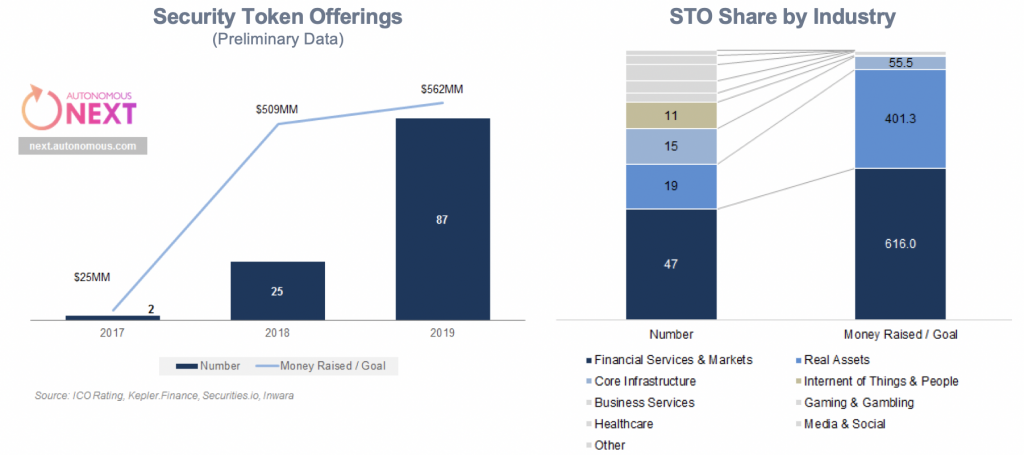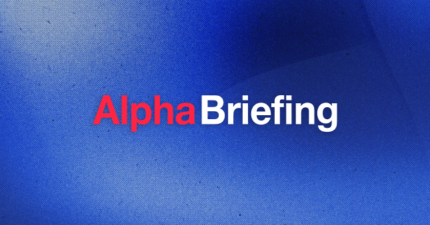10 Ways Security Token Offerings Improve the Traditional Securitization Process
Author: Asha Dakshinamoorthy
If you’ve been following the blockchain industry, you may have noticed a wave of news about security token offerings (STOs), tokenization, or tokenized assets in the past year. In 2019, preliminary data from Autonomous Next indicates that 87 institutions are on track to raise $562mm by issuing shares via Security Tokens, aka Security Token Offering.

Source: Autonomous Next
But what do these terms actually mean? And how does this impact the securitization industry as we know it today?
To start, a few quick definitions are helpful:
Tokenization: The act of representing an asset, such as a financial product, physical asset, ownership, or right, on a blockchain or distributed ledger system.
Smart Contract: The unique code on a blockchain system that represents the digital asset that was “tokenized”. Within that smart contract you can assign specific data or attributes, link documents, or enable business logic.
Security Token Offering: The act of issuing a new digital asset that represents a traditional security to a group of investors or users.
We’ve seen several names emerge: digital securities, tokenized assets, security tokens, and so forth – but in the context of traditional securitization, these simply refer to the age-old process of issuing, distributing, managing, and trading both financial assets and real, physical assets. What is defined as a security depends on the country in which you reside, but we can look at this from the perspective of some familiar asset classes:
Financial Assets:
- Debt and Derivatives: Bonds, Mortgages, Derivative Securities, Loans
- Equity and Funds: Private Company Shares, Fund Interest, Project Finance, Trusts, Real Estate Investment Trusts (REIT)
Physical Assets:
- Exclusive Assets / Luxury Goods (Example: Diamonds, Gold)
- Commodities
- Real Estate
Tokenization is simply the process of creating a digital right or unit of ownership in one of these classes on a blockchain or distributed ledger system. Therefore, a security token could represent shares in a fund, or the right to a gold bullion bar, or the interest payment on a bond class. However, tokenization also enables issuers to take a single asset, such as a gold bullion bar, and create a fractional ownership model by creating multiple tokens that link to a single underlying asset. For example, several people could own tokens that represent the right to a fraction of a single bullion bar.
Why is tokenization on blockchain better than a traditional securitization process?
Blockchain and distributed ledger technologies have three distinct features that significantly improve financial market infrastructures by reducing overhead cost, creating operational efficiencies, and enhancing liquidity.
Blockchain technology enables issuers, operators, and investors to:
1. Program specific rights and restrictions for each unique digital asset: This is accomplished through a smart contract, in which rights and restrictions are managed and enforced by being programmed into each digital asset, or into each individual token. By contrast, with traditional technology implementations, these rights and restrictions are managed and enforced by an exchange.
2. Execute trades between two digital assets in near-real time, without the use of an escrow service: The security and interaction of a blockchain system enable two parties to exchange value directly. As an example, two parties can each have one of two digital assets, one that represents $1 USD, and one that represents 1 share of a private equity fund, and these could be exchanged between two parties in near real-time on a blockchain system.
3. Maintain a complete audit record for each token transaction: Each event, asset transfer, and trade are recorded on the blockchain in a secure system that can be queried at any point to provide real-time information. Moreover, the data, documents, and information about the digital asset live with it through its lifecycle, in a centrally available system of record.
In the context of the securitization lifecycle, there are 7 benefits that alleviate inherent inefficiencies in capital allocation, illiquidity, and operational procedures:
Primary Issuance
1. Compliance and Flexibility: Securities created via smart contracts enable flexible, programmable compliance at the asset level, rather than at the exchange level. This ensures restrictions directly related to the deal-structure (e.g., whitelist for accredited investor, a cap on the number of investors, a restricted holding period) are encoded in the security itself and are enforced throughout the life of the token.
2. Lower administrative costs: The share creation and distribution processes are simplified by creating tokens directly to the appropriate account and distributing them to investors on the blockchain system. Overtime this will reduce overhead audit, legal, and technology costs.
3. Clear provenance to underlying asset value: Reduce counter-party risk and directly tie token value to associated financial or physical products.
Secondary Trading
4. More liquidity: Compliance at the asset level instead of the exchange level means that investors, issuers, and operators are not locked into a single pool of liquidity. With the opportunity to access multiple exchanges, the lack of price discovery and illiquidity discount typically associated with private securitized assets can be reduced and/or eliminated over time.
5. Real-time settlement: Coupled with on-chain payment rails (either currency-pegged “stable-coins” or cryptocurrencies), trades benefit from near-real-time settlement, greatly reducing operational costs of exchanges and contributing to investor liquidity.
Lifecycle Management
6. Efficiency: With a real-time ledger of asset ownership available, coupled with on-chain payment rails, management activities (e.g., dividend distributions, profit-sharing, buybacks and remittances) can become automated and highly efficient.
7. Investor Reach: Without the burdensome overhead and lifecycle processing simplified, it becomes much easier for an asset manager to reach a larger investor base.
Asset tokenization and trading generates meaningful benefits for issuers, broker dealers, and investors alike – access to more capital, enhanced liquidity, faster onboarding, more efficient processes, real-time settlement, and streamlined compliance.
In future posts in this series, we will discuss security token market trends, and provide deeper overviews of the process of creating and managing security tokens for specific asset classes.


